In May of 2008, just as my first Puddle Duck Racer (PDR206 “PracticeWun”) was nearing completion I heard rumblings that three of my fellow mates were going to run the TX200 in their ‘ducks. I had two thoughts; the first was, “Those guys are nuts!” and of course the second was, “I wish I could go too.” Sadly, the boat I had built was optimized for speed, not cruising (with only 8” of freeboard and no spray deflector I would have been constantly awash) and I was just not all there financially to put such a trip together. Dreamers dream though, and I began sketching out ideas for a new boat to take on such a journey. Twin shoal keels and a dry-storage compartment up front were the dominating features of the first design, as was higher freeboard and a spray deflector up front.
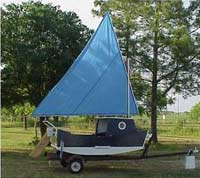 |
Jason Nabor’s PDR#33, the “Sea Flea” in its original configuration. |
By the end of June of ’08 we were getting a good amount of feedback from that first group. The biggest shock was the failure of the shoal keels to hold the boats against the strong gulf winds encountered. The first designed feature I had used got tossed aside right-quick. Later in the discussions, John Wright pointed out that you spend a third of the time asleep so you better make it a comfortable third. The bulkhead for the dry-storage cut the cockpit space down to 4-feet of length. No good; back to the drawing board then.
Andrew Linn skippered PDR#203 “Duckaneer” through the 2008 TX200 |
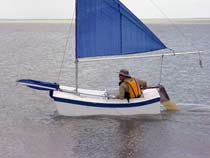 |
The issue of lateral resistance occupied most of my time. After all, two of our guys were put in some very dangerous spots because of their poor windward performance. As much as I enjoy a good adventure, being blown sideways out to sea is one I think I’ll give a pass on. Lee boards are a good solution to the problem, except I’m far too vain for my own good and I just don’t like how they interrupt a boat’s lines. I was working on a swinging centerboard option but I was unsure on a number of technical issues and discarded the idea. That was about the time that Practice’s rudder came apart on me in 20 mph winds out on Sprague Lake. No rudder makes steering interesting and I missed my first attempt at docking the crippled craft, grounding hard on the rocks instead. The dagger board case held up against the impact just fine and after freeing her I made it to the dock on my second attempt. The fear of breaking the case in a grounding event left me (it really was a spectacular crash). So seeing that I’d used dagger boards my whole sailing life I decided might as well go with what I knew how to use.
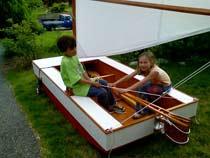 |
PDR#206 “PracticeWun” was made more for day-sailing and racing. She makes a very poor expedition craft. |
The issue of sleeping space and the issue of having a dry-storage space as close to the boat’s center-of-gravity as possible were not meshing well at all. Frankly, I hate pitching tents almost as much as I hate getting wet so sleeping on board was more or less a must for me. I knew there had to be a simple solution that I just wasn’t seeing. That was when John Wright showed me a picture of Derek Van Loan’s dingy “Sleeper”. It looked like the perfect solution; interior space is divided between a small cabin up front and leg-room up under the cockpit seats. Cargoes could be netted in place around the dagger board trunk while underway (placing it right at the boat’s COG) and then moved to the side you weren’t sleeping on at night. Perfect! Most people compared the new design to a coffin, but after riding on main battle tanks for eight years I’m more than used to cramped spaces. Heck, compared to the gunner’s station on an M1 it’s absolutely spacious inside, and I had slept there on many nights so the ability to actually lie down would be luxurious.
| The 62 sqft gaff-rigged mainsail I designed has an aspect ratio of 2.34:1. Less than intended but it can be cut from a 10x12 poly tarp. |
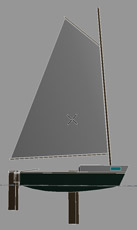 |
To power the contraption, I had initially thought of using the tried-and-true Bolger 59 spritsail but once again conversations had with our vanguard convinced me that in inability to effectively reef would be crippling so I had to find another solution. I thought of using a Bermuda rig since I had learned to sail on one of those; but like the three-sided sprit the COE wanders forward quite a bit when reefed so I wound up ruling it out. I had used gaff-rigs before (on Andrew Linn’s Weekender no less) but I had never designed or made one. They handle a lot like the Bermudas though and its COE doesn’t move as much when reefed which I thought would be preferable for such a short boat. First time for everything I suppose. I didn’t like the aspect ratio of the Weekender’s mainsail though (it’s under 2:1 if I remember right) so I figured I’d take a crack at designing one myself with an AR between 2.5 and 3.5:1 for good all-around performance. For this I contacted our resident expert Michael Storer for help on designing the sail’s curves and between him and a HUGE tutorial given to me by Dave Gray (of “Polysail” fame) I’m feeling quite confident that it’ll work just fine.
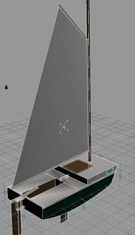 |
Computer generated 3D model of PDR#286 “Ranger”. Lookin’ good in white and evergreen colors! |
So there she is, laid out in paper with all the basic features I’d been looking for. I’m just beginning to get it in plywood so we’ll have to see what adventures await as she comes together in 3D.
Until then, sawdust and spray
Jon K
On to Part 2
***** |

